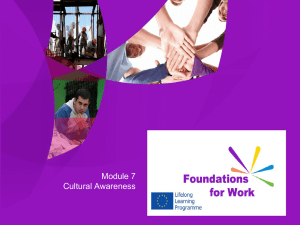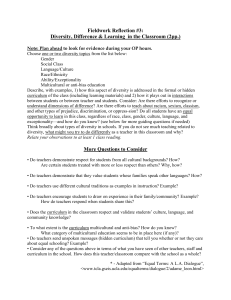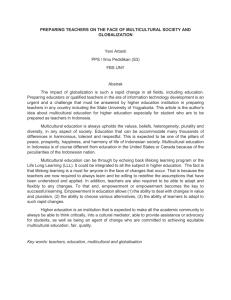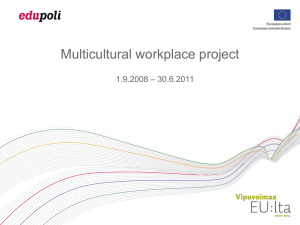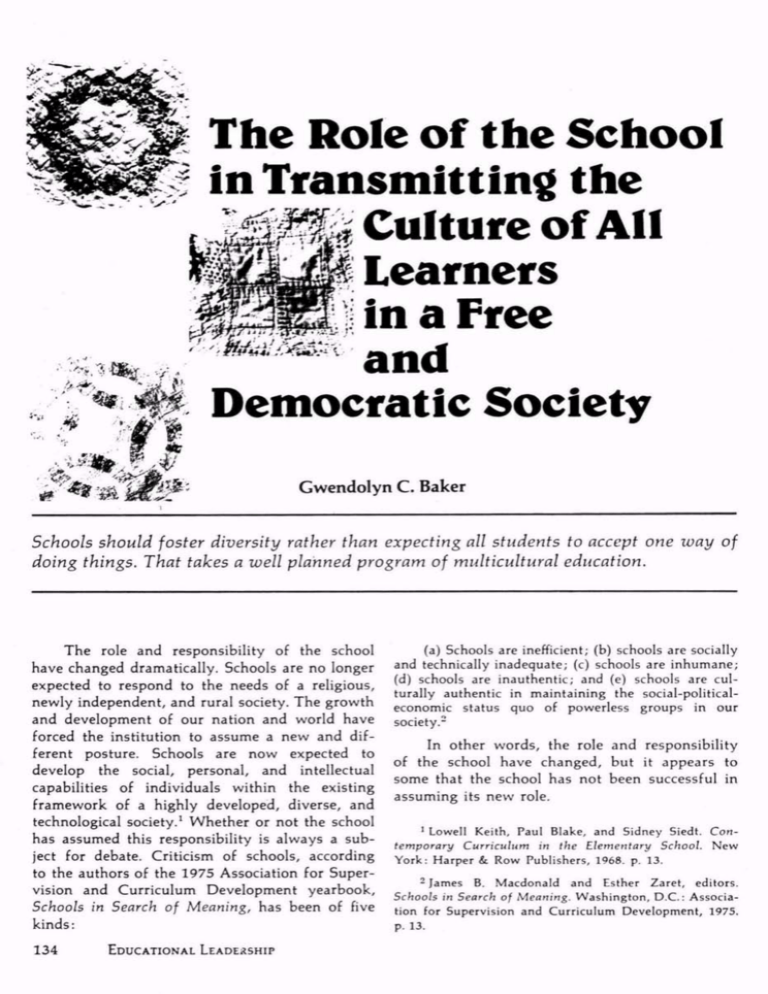
The Role of the School
in Transmitting the
Culture of All
Learners
in a Free
and
Democratic Society
,v^%-.*^
4&M,&
••&~ "•&.&$?'
Gwendolyn C. Baker
Schools should foster diversity rather than expecting all students to accept one way of
doing things. That takes a well planned program of multicultural education.
The role and responsibility of the school
have changed dramatically. Schools are no longer
expected to respond to the needs of a religious,
newly independent, and rural society. The growth
and development of our nation and world have
forced the institution to assume a new and dif
ferent posture. Schools are now expected to
develop the social, personal, and intellectual
capabilities of individuals within the existing
framework of a highly developed, diverse, and
technological society. 1 Whether or not the school
has assumed this responsibility is always a sub
ject for debate. Criticism of schools, according
to the authors of the 1975 Association for Super
vision and Curriculum Development yearbook,
Schools in Search of Meaning, h as been of five
kinds:
134
EDUCATIONAL LEADERSHIP
(a) Schools are inefficient; (b) schools are socially
and technically inadequate; (c) schools are inhumane;
(d) schools are inauthentic; and (e) schools are cul
turally authentic in maintaining the social-politicaleconomic status quo of powerless groups in our
society. 2
In other words, the role and responsibility
of the school have changed, but it appears to
some that the school has not been successful in
assuming its new role.
1 Lowell Keith, Paul Blake, and Sidney Siedt. Con
temporary Curriculum in the Elementary School. New
York: Harper & Row Publishers, 1968. p. 13.
2 James B. Macdonald and Esther Zaret, editors.
Schools in Search o f M eaning. Washington, D.C.: Associa
tion for Supervision and Curriculum Development, 1975.
p. 13.
The curriculum of the school is much the
same today as it was years ago. The program is
varied and the list of offerings more extensive,
but for all practical purposes the focus has re
mained the same. The school and its curriculum
have focused on one group of people, and all
activity and instruction have had a monocultural
thrust. The culture of the majority has been
transmitted to all learners. Our schools have
presented one set of values, one type of life
style, and one mode of behavior, and have ex
pected all students to accept this.
Until the present decade, most did accept,
but those who could not and would not brought
a new force to bear on curriculum change. At
tempts at curricular change and revision have
been made, but they have taken a patchwork
approach. Curricular responses to meet the cul
tural needs of all learners have resulted in at
tempts to implement multicultural education.
Much of what has been accomplished has been
done in piecemeal fashion. Little thought or plan
ning has been given to the process of multicul
tural education or to the manner by which it can
be integrated into the total curriculum.
Multicultural Education: A Process
If the school is to assume the role of trans
mitting the cultures of all learners in our society,
then the curricula of the schools must reflect the
cultural diversity of its students. Multicultural
education should be viewed as a process.
Multicultural education is a process through
which individuals are exposed to the diversity
that exists in the United States and to the rela
tionship of this diversity to the world. This
diversity includes ethnic, racial minority popula
tions as well as religious groups and sex differ
ences. The exposure to diversity should be based
on the foundation that every person in our society
has the opportunity and option to support and
maintain one or more cultures, i.e., value systems,
life styles, sets of symbols; however, the individ
ual, as a citizen of the United States, has a re
sponsibility of contributing to and maintaining
the culture which is common to all who live in
this country. 3
According to Herman, "The task of the
school, then, is to foster diversity but within a
framework containing some common understand
ings." 4
Developing Multicultural Curricula
To avoid a patchwork approach to develop
ing a multicultural curriculum, it is necessary to
take a global approach to planning. In other
words, careful planning must be exercised to
ensure that the learner has consistent and con
tinued exposure to cultural diversity. This can be
accomplished if the planning for multicultural
Figure 1.
A Model for Developing Multicultural Curriculum
International
*
U.S. Cultures
*
Ethnicity
U.S. Cultures
^
(Ethnic, Racial Minorities. Religions. Sex)
U.S. Ethnic/Racial
Minority Participation
Community and State
Diversity
Family Variations
Individual
Differences
education begins with the earliest learning ex
periences of the child for whom the school has
responsibility. A conceptual approach that begins
in the primary grades and continues throughout
secondary schools can be effective. Objectives and
goals should be consistent with the life experi3 Gwendolyn C. Baker. "Multicultural Imperatives for
Curriculum Development." Teacher Education 2 (1): 73;
1977.
4 Louise Herman and Jessie Roderick, editors. Feel
ing, Valuing, and the Art of Crowing: Insights into the
Affective. Washington, D.C.: Association for Supervision
and Curriculum Development, 1977. p. 255.
NOVEMBER 1978
135
ences of each learner. Figure 1 suggests a type of
graduated learning experience that can accom
plish this.
As indicated in the model, children in the
primary grades can be exposed to individual
differences. The learning that occurs should sup
port the positive aspects of individual differences.
This can best be accomplished by helping the
learner appreciate and value differences first and
similarities second. Children who can accept dif
ferences positively in themselves and others will
have little difficulty understanding more obvious
cultural and ethnic variations later. Integrating
the basic concept of individual differences
throughout all of the primary learning experiences
will provide a foundation for understanding other
kinds of diversity.
As the learner progresses through Phase I
of the model, accepting variations in family pat
terns and structures will be a natural step. While
it may appear to some that family variations have
little to do with multicultural concepts, this is not
necessarily so. To the contrary, this concept is
important in developing the necessary framework
on which later to base more complicated under
standings as they relate to diversity. Once the
learner realizes that there are many varieties of
family patterns and styles and that all are ac
ceptable, it is easier to move to the next level.
Exploring other kinds of diversity outside of the
immediate life experiences of the student prepares
the learner for an understanding of ethnic/racial
differences found in the United States.
This approach minimizes the exposure of
the learner to ethnic/racial differences in the
primary years and suggests that these differences
are best handled by the student in the interme
diate grades. The rationale for this progression
is that one should understand self, family, and
the more immediate type of differences before
attempting to grasp the variations produced by
ethnicity and/or race.
As indicated further by Figure 1, a complete
exposure to the various cultures within the
United States (ethnic, racial minorities, religions,
and sex) is not attempted until Phase II when
the learner has moved into the second half of
school experiences. An appreciation and under
standing of world cultures should be the focus
once all else has been explored. Curriculum plan
136
EDUCATIONAL LEADERSHIP
ning in this fashion can offer a more organized
way of providing for a transmission of cultures
to all learners.
Implementation
Once the overall plan for developing a multi
cultural curriculum has been completed, attention
should be given to classroom implementation.
"The school can be effective in transmit
ting the cultures of all learners. Curricu
lum planning is essential if the school is
to move from a monocultural approach to
a multicultural one that will meet the cul
tural needs of all students."
The concepts to be developed, the objectives to
be achieved, and the level of progression should
be readily available to curriculum personnel and
teachers. This can be accomplished through inservice training.
An impediment to successful implementation
can be the concern that instructional personnel
may have about acquiring enough knowledge
about various cultures to ensure effective teach
ing. This concern can be minimized if teachers
realize that implementation requires a minimal
amount of knowledge to begin. Most have what
is needed to make a successful start, but may
need direction in how and where to begin to
integrate multicultural concepts throughout all
instruction. Once the implementation stage is in
operation, acquisition of more knowledge is neces
sary to continue the process. It may be helpful
to suggest three stages that can guide teachers
into implementation.
The first stage can be thought of as the
acquisition s tage. This is the period when one
is becoming sensitive to cultural diversity, the
impact of culture in one's own development, and
the importance of culture to others. This stage
can also be considered as a time when one begins
to establish a knowledge base. This stage is never
completed but does foster the move to stage II.
Stock No.: 611-75046
87pp.
$4.50
Orders under $10.00 must be prepaid.
AMoclMlon lor Supervision ind Curriculum Development
Suite 1100. 1701 K St., N.W., Washington. DC. 20006
This can be considered the period of development.
The development stage is the time when one
forms a rationale or philosophy that supports
multicultural concepts and objectives. The final
stage is the involvement period when implementa
tion occurs. At this point the teacher is providing
relevant content, appropriate instructional strate
gies, and related material. Once implementation
occurs, at whatever level, stage I is repeated until
a sufficient body of knowledge is gained so as to
provide for full integration and classroom im
plementation of multicultural concepts, content,
and approaches. 5
In providing guidance for teachers who are
to be involved in implementation, the following
process may be helpful. This process contains
three levels of development: initiating, integrat
ing, and enriching.
The multicultural instructional content and
activity that occurs in the i nitiating level is mini
mal. This is the point at which the elementary
teacher selects one or two subject areas or one
or two aspects of the learning environment in
which to integrate multicultural content. In the
case of the middle school or secondary teacher,
138
EDUCATIONAL LEADERSHIP
it will be a phase or two of the specific subject
area for which the teacher is responsible. Specifi
cally, this may mean choosing to integrate read
ing, social studies, or art activity with relevant
content. It may also mean integrating a unit in
English, history, or science with multicultural
concepts. Bulletin boards and other audiovisual
materials should also create an environment to
foster diversity. This level is a place to begin and,
once the teacher is involved, the progression to
the next level can be a natural move.
The level that follows will find the teacher
integrating throughout all subject areas or in the
entire subject so that multicultural concepts and
content are pervasive. Meaningful multicultural
content should only be included as it is appro
priate and relevant to the instructional activity.
Integrating the involvement of diverse cultural
groups with related subject matter should be done
as naturally as possible.
The final level of enriching allows the teacher
to build upon what has been established in the
first two levels. It will be necessary for teachers
to increase their knowledge base and acquire
additional information so that the enrichment
process can take place.
The school can be effective in transmitting
the cultures of all learners. Curriculum planning
is essential if the school is to move from a monocultural approach to a multicultural one that will
meet the cultural needs of all students. Imple
mentation of a multicultural approach to educa
tion can be successful if it is approached carefully,
deliberately, and sincerely. SL!
5 Gwendolyn C. Baker. "Instructional Priorities in a
Culturally Pluralistic School." Educational Leadership
32(3): 176-78; December 1974.
Gwendolyn C. Baker is
Chief, Minorities and
Women's Program, Dis
semination and Im
provement of Practice
Croup, National In
stitute of Education,
Washington, D.C.
Copyright © 1978 by the Association for Supervision and Curriculum
Development. All rights reserved.




